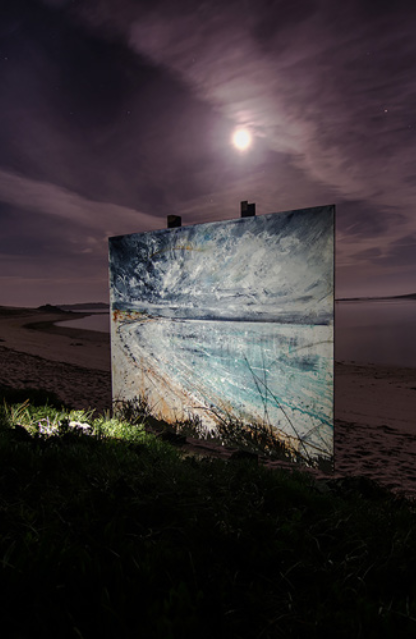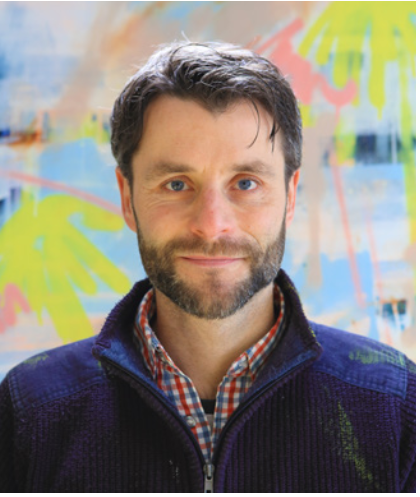Sounding Board

Landscape paintings of the natural environment don’t often have much to say. It’s usually about the artist’s interpretation of what they see, how they want to represent it, and with what skill they play with the aesthetics. Rarely do we see a narrative. Totnes-based Anthony Garratt, though, is all about the story.
His work has taken a journey of its own. Once upon a time, his big canvases drew comparisons with those of traditional landscape painters. Great sweeps of ocean or furrowed land, looming skies, a hint of a storm or a glitter of weak moonlight. These days, though, he’s moved on from that, and his work is more in the category of ‘experimental landscape’ – the name of the course that he teaches at Newlyn School of Art. Having done a foundation course in Art and Design in Chelsea, and graduated from Falmouth University, Anthony headed to London for a job in design for a marketing agency. Drawn back to the West Country, he moved to Bristol in 2005, where he worked freelance as a marketing and branding designer – all the while painting in his spare time. There’s a highly practical side to this young artist – for all his creativity, he is grounded and attuned to the realities of making a living in a world where making a niche for yourself (and shouting about it on the internet) is absolutely vital.
Anthony’s paintings, he says, have been in a
constant state of development. Perhaps one of the
biggest shifts has been from depicting straightforward
landscapes to incorporating a narrative. As someone
who grew up on a smallholding and with parents who loved sailing (“I used to hate it,” he admits,
“Before you understand it, it’s just horrible and wet”),
Anthony’s engagement with the landscape is intrinsic
to who he is. He now loves sailing and has crewed on racing boats, including in the notorious Fastnet:
“It’s a dodgy bit of water, but there’s something really
exciting about a storm and being in a team together.”
It’s this passion that drew him to study at Falmouth,
where he also got into surfing. Seascapes have
dominated his art in the past and inspired him to create
his first series of canvases as installations on the island
of Tresco in the Scillies.

The four paintings were set up and left in the landscape for 18 months. “It was a gamble,” says Anthony, remembering the process. “The idea of exhibiting paintings long-term outside is not something that’s been done very much. I was basically putting all my money into this project and I didn’t know whether it would pay off.” He discovered that installing a big canvas on the edge of an island is more technical than you might think. “There’s something challenging about the fact that it’s basically a huge solid sail. There’s a lot of engineering that has to go behind it.” He asked Falmouth architect Michael Hormann to help him, and they worked with shipwrights Mark and Loz Cann from Falmouth to build them.
By good fortune, a visitor to Tresco and owner of a business on Anglesey, contacted Anthony to create a landscape installation on the four corners of Anglesey. Bun Matthews has since become a patron of Anthony’s work, particularly encouraging him to continue with the eye-catching – and marketing-friendly – landscapes as installations. The Four on Anglesey certainly made you stop!
Anthony was more determined to incorporate a message in his art. His next undertaking in North Wales was to give him this impetus. The installation, in 2016, called High and Low, was painted in situ in Snowdonia and was a treatise on the steady decline of the mining industry in contrast to the scenery above ground, whose only changes are in the wind and the weather. The canvases were huge, and Anthony decided to install one in a deserted slate mine, while the other, a double-sided landscape, was to float on a raft tethered to the middle of a lake at the foot of Snowdon. The engineering side of the project appealed to him, and he asked Mark and Loz to help. The result is a painting that spins and drifts with the wind and the movement of the water. The underground canvas has paints that are imbued with rust to symbolise and mimic the decline of the mines, and it sits in a slate mine as part of an educational exhibit.

Anthony’s latest outdoor project is back on Anglesey supported by Bun Matthews and her luxury holiday business. Now fully engaged in the idea of telling a story through his landscapes, he has incorporated another passion of his: music. An accomplished pianist, he wrote and performed a score for the High and Low video, and now he wants his five-metre wide painting to make music. Sitting in his freezing cold studio in an old bakery in Totnes, surrounded by static pieces of art that are clearly not about to start producing any melodies,
I struggle to understand how this is even possible. The Anglesey canvas, explains Anthony, will be like a giant weather vane. It will catch the wind and move like a sail. And every time the wind moves it, the data from its movements will form a musical score. I can’t hide my confusion. Patiently, Anthony goes into more detail: “We’re working out the way of the wind at five to six each day – the time of the shipping forecast – and drawing an arc of direction change. So, it’s basically a line on a circle each day. The circle will be broken down into eight sections which forms an octave. That constitutes the length and nature of notes for that day.”
And if you understand that, you are a better person than I. The end result, apparently, is that there will be a theme – a sort of dong dong dong – caused by the prevailing wind. The rest of the notes will form a composition that will be performed by a Welsh male voice choir and a concert violinist, Philippa Mo. But that’s before we even get to the painting itself. For that we need to go back to 1859 when a terrible storm wrecked The Royal Charter, a steam clipper en route from Melbourne to Liverpool. It went down off the coast of Anglesey and over 450 people died. Many other ships were sunk in the storm that night. It led directly to the introduction of the gale warning service, which still exists today. Anthony’s painting will depict that storm and will be positioned off the coast – viewable, he says, through a telescope. There’s some social commentary implicit in this, too: “As a whole, people tend to be quite inward-looking these days,” Anthony says thoughtfully. “People are looking at their phones – I don’t think kids are engaging with heritage much anymore. So, these projects are a way of inspiring people to look up and out at a piece of history.”

While this five-metre wide installation will be launching in March, there are many other strings to Anthony’s bow. Not one to be pigeonholed, he continues to experiment – there are landscapes from his recent residency in South Africa, a place close to his heart: “I’ve got cousins and family there. My mum was born in Zambia. I love Africa. I’ve travelled a lot through Zimbabwe and Zambia. Uganda...” He accepted the residency, he says, partly because it was in an area that is being re-wilded after centuries of overgrazing. “They ruined the land completely. Now, the locals are trying to make it an extension of the World Heritage Site and gradually allow freedom of movement for animals. Leopards, especially. It’s a lovely project.” He painted big, raw landscapes that touch on the abstract – emphasising the dry, desolate soil, some with a hint of lush green in the distance. He also developed a series of stylised architectural images of views across the veld from the sharp white lines of a veranda. They are strikingly different from his other landscapes.
“I’m quite an erratic painter. I paint in about four different styles at once. Which is a bit confusing for people,” says Anthony, casting his eye over the many paintings propped up around his studio. The style is evolving, the landscapes incorporating more abstract elements: graffiti-like Day-Glo streaks; raw materials from the site. There are collages made up of landscape paintings that have been torn up and hashed together to form semi-abstract, almost Cubist images. And there is a series of surreal collage-like works which will form the next London exhibition – a collaboration with landscape photographer Barry Cawston. Cawston’s sweeping Ansel Adams-esque photographs are daubed over and tinkered with by Anthony’s distinctive brushwork to create dream-like vistas. It’s not for nothing they are calling the show ‘Disturbia’.
Anthony is very clear-sighted about his own artistic journey – he is starting to understand how his experimentation can take him in new directions. He is learning to find his own brand outside of his gallery shows (he is represented by Thackeray Gallery, London). He is starting to make his voice heard – to spread his wings creatively. “Previously, I was just practising painting,” he says. “There wasn’t much intellectual content behind it, I suppose. Which is an important stage to go through. You never learn to paint, you just accumulate tools and ways of using marks.” With other major projects on the horizon (quite literally), it seems as though those tools and marks may well be coming together to bring Anthony Garratt onto a bigger platform. Watch. This. Space.


